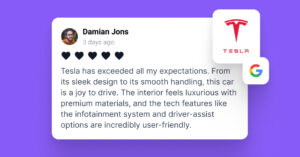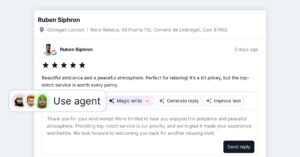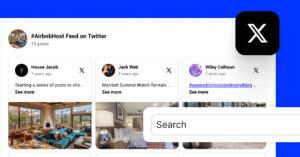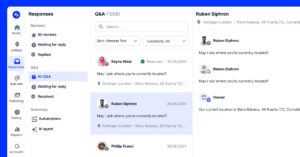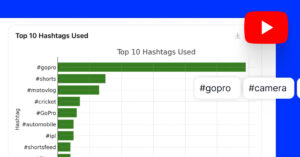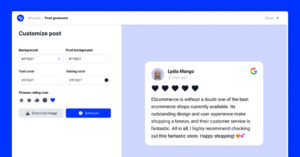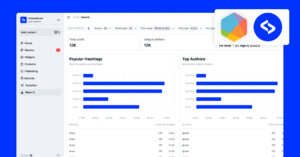A new year means new opportunities. The only constant in pandemics is change, especially when it comes to social media platforms.
Social media has been a blessing for marketers and users during COVID-19.
Access to social media and interaction with friends and family have helped boost users’ moods, give them a sense of well-being, and survive the required social distancing.
On the other hand, we have marketers who understand social media’s importance in consumers’ lives, encourage offline customers to transfer online and hurry up to connect and engage with their target customers’ favorite platforms. And the rise of user-generated content and creator economy skyrocketed.
The social media landscape is changing so fast. There is a need to stay up to date with the latest trends emerging now more than ever. To address this, we gathered all the latest social media trends you need to fuel your social media strategy and connect to our audience on their favorite platforms.
This post will share the latest social media updates, analyze their current adoption, and predict future social media trends.
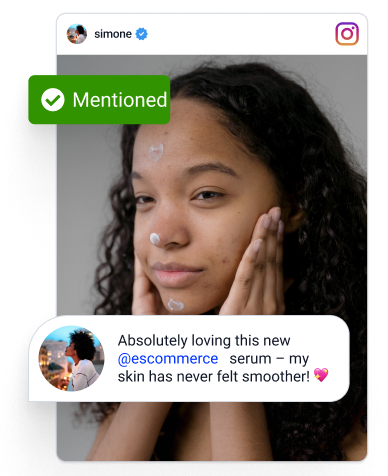
Turn Instagram Mentions Into Sales
Embed Instagram mentions and boost trust with real user-generated content.
1. Direct-to-consumer interactions becoming more direct
The pandemic was a test of how capable are brands to gain the trust of their fans. Those brands that encouraged users’ content, whether employees, influencers, or shoppers sharing their experience or asking questions, outperformed their competitors effortlessly.
This served as a good lesson – it’s not about the production value anymore, but the quality of human connection that matters. Building trust through interacting with fans shows to be a must-have in 2021.
Several social platforms developed features to tackle precisely this:
Organize paid online events on Facebook to engage your audience
We know that nothing beats the value of face-to-face meetings. However, in times of coronavirus, online events come as a blessing.
Since its introduction, Facebook’s paid online events feature has helped thousands of event professionals organize their events virtually. Additionally, this allowed many creators to reach wider audiences and monetize their online efforts more effectively.
As a result, the feature has led to hosting different kinds of online events such as virtual tours, make-up tutorials, live podcasts, etc.
Since then, the paid online events feature has only been available in 20 countries. Facebook announced bringing it to 24 more countries.
We expect this feature usage to grow tremendously by giving many content creators and event organizers another way to monetize their Facebook presence by hosting paid events.
Go more direct on TikTok with Q&A options
Although YouTube still rules the long-form videos, when it comes to engaging with fans, TikTok is mastering it. The platform announced launching a new Q&A option that will allow users to ask creators questions that will be answered in the upcoming video clips.
This is how it will look like:
New! TikTok’s got a Q&A feature!
— Matt Navarra (@MattNavarra) January 19, 2021
Creators can add Q&A button to profile allowing followers to leave questions which they can answer via video replies or in a livestream
h/t @Sphinx pic.twitter.com/aMHt4WGhyC
As you can see in these screenshots, creators can have the option to switch on the new Q&A function. Once the Q&A icon is enabled, users can pose questions via the creators’ profiles.
When tapped, viewers can type their questions in the composer.
Creators can see the list of queries and use it to prepare answers for their next video content. Additionally, visitors can also see the list of questions users have asked the Creator and even vote for their favorite one. Awesome, right?
This is not a direct competition to Reddit or Quora, but it’s definitely an innovative way to prompt fan engagement and maximize connection within the app. We cannot wait to see how this will work in practice.
2. Niche social media platforms are becoming more popular
AI-driven personalization enables businesses to tailor content and ads to individual user preferences. By analyzing user data, AI creates personalized experiences, making content more relevant and engaging. This not only enhances user satisfaction but also increases the effectiveness of marketing efforts. For instance, targeted advertising becomes more precise, reaching the right audience at the optimal time with messages that resonate.
A real-life example of AI-driven personalization in action is Spotify’s “Discover Weekly” feature. This feature uses AI to analyze a user’s listening history, comparing it with the listening patterns of others with similar tastes.
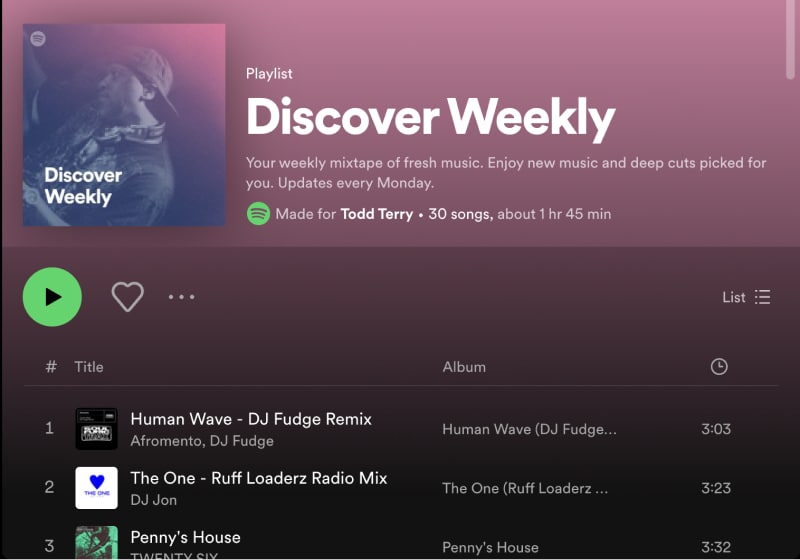
Every week, it presents the user with a personalized playlist of songs they have never listened to but are likely to enjoy. This not only keeps users engaged with new and enjoyable content but also encourages exploration within the Spotify platform, often leading to increased subscription retention and customer satisfaction. This approach of using AI to deliver personalized experiences has set a benchmark in the industry, illustrating the power of AI in enhancing user engagement on a large scale.
3. Influencer Marketing will continue to grow
The popularity of TikTok and Instagram influencers skyrocketed in 2020. This trend significantly escalated during the extended lockdowns that inspired people to become content creators and attract a huge follower base.
These networks are top-rated among millennials, but seemingly, for specific industries, LinkedIn is getting the throne from the more traditional ones, such as Twitter, Snapchat, and Facebook.
Most brands try influencer marketing to see how it works, but to find the right niche influencers, most of the brands have gone all in.
Nearly 90% of all marketers find ROI from influencer marketing comparable to or better than other marketing channels.
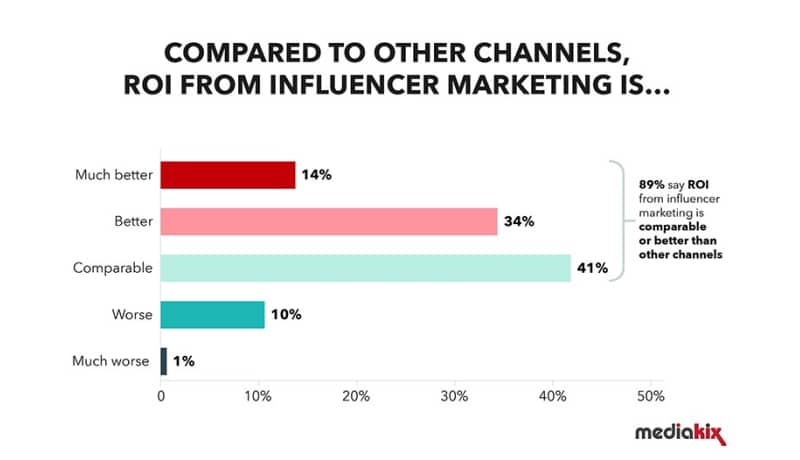
Now, as 2021 is unwrapping influencers, and their power in specific industries is undeniable. For example, once a prominent fashion influencer posts a photo of the latest winter collection or creates a live video showing how it looks on them, the brand can expect it to sell out in a matter of hours.
This power was never seen before in any other channel – mostly because of these people’s enormous reach.
Influencers have indeed adopted the short-form video format such as TikTok and Instagram Reels videos. We should expect this format to continue getting immense exposure and, thus, more significant users adoption.
4. User-generated content becomes a must-have section for e-Commerce websites
UGC continues to be the center of building trust and supporting customers in making better purchasing decisions.
Individual influencers and creators will drive brand recognition and be the first to provide reviews and promote new products.
And brands are already aware of the power of the content they create around their products.
Having social media aggregation tools such as EmbedSocial, brands can aggregate the UGC created by other people on social media and sync it with their website.
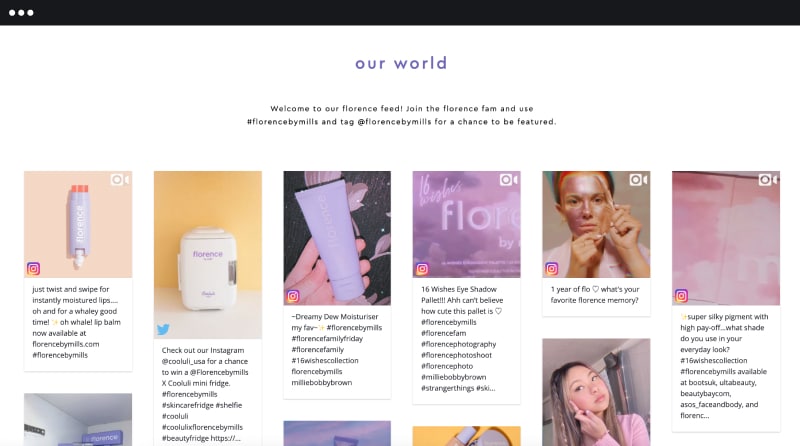
Social listening will help you be on top of your brand mentions. So, don’t forget to track, analyze, and respond to conversations about your brand on social media and show them on your website.
5. Social commerce leading the hyper-adoption of new products
As we mentioned, influencer marketing is already the main channel for building awareness and is becoming the secret weapon for convincing customers to make a purchase.
Therefore, social commerce will exponentially grow in the coming years.
And the numbers are here to prove this trend:
‘In 2019, social commerce sales in the United States were estimated at 22 billion U.S. dollars. As social media’s influence continues to increase, U.S. social commerce is projected to reach 84.2 billion U.S. dollars in 2024 and account for 7.8 percent of U.S. retail e-commerce sales.’
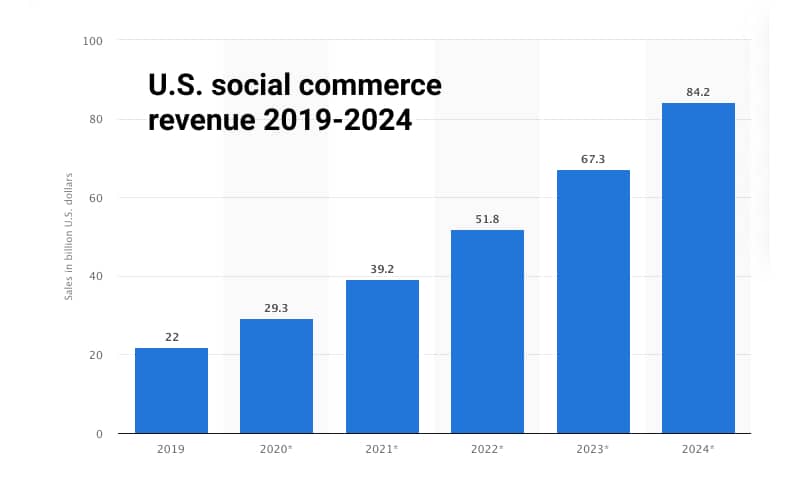
6. Programmatic advertising is becoming mainstream
The proliferation of digital channels has made it so hard for marketers to correctly target prospects with the right message, on the right device, and at the right time.
Faced with these challenging market dynamics and increasing pressure for ROI, marketers can rely on the functionalities of social media platform ads that are getting even more advanced options as time passes.
Targeted automatic advertising allows marketers to understand the networks’ algorithm and use the wide availability of demographic data to create relevant marketing campaigns, save time, and reach out to more people.
Here are the latest updates that are changing the game in social media ads:
TikTok personalized ads based on users’ in-app activities
Starting on April 15, the ads you will see on TikTok will be based on what you do on the platform, such as liked videos or previous interactions with ads.
Currently, you might notice ads that have nothing in common with your TikTok activity. However, this will change soon.
To make ads even more personalized, TikTok will use third-party data from their advertising partners. Still, as a user, you will remain in control by managing these settings via your profile.
These changes will roll out worldwide. An exception will be the European Union countries, where GDPR makes it challenging to implement this transition.
Save time with automatic Pinterest ad targeting and creation
Pinterest is trying hard to rank as “the destination for personalized shopping.” The latest update shows that they are on an excellent path to achieving this goal.
The platform announced launching a new way to automate tailoring ads to different audiences with a new ad specialty – dynamic creative.
This is a massive deal for advertisers. Apart from saving them time and resources, they will automatically create hundreds of ads with unique messaging to their desired target audiences.
Additionally, this will allow them to test various creatives and identify which elements drive higher performance.
Once the update is rolled out, advertisers can use Dynamic Creative platforms such as RevJet, StitcherAds, and Smartly.io to design their own performance-driven Pins with dynamic audience-specific messaging.
7. Social media Stories will out-throne the Feed
The Stories format seems to be on every leading social platform for a reason. Stories proved to be one of the most popular growing social media trends among users. Their usage growth indicates that they are here to stay (and marketers should use that wisely).
Due to the fast adoption of the format, Facebook already predicted that the Stories views would overcome their Feed’s views.
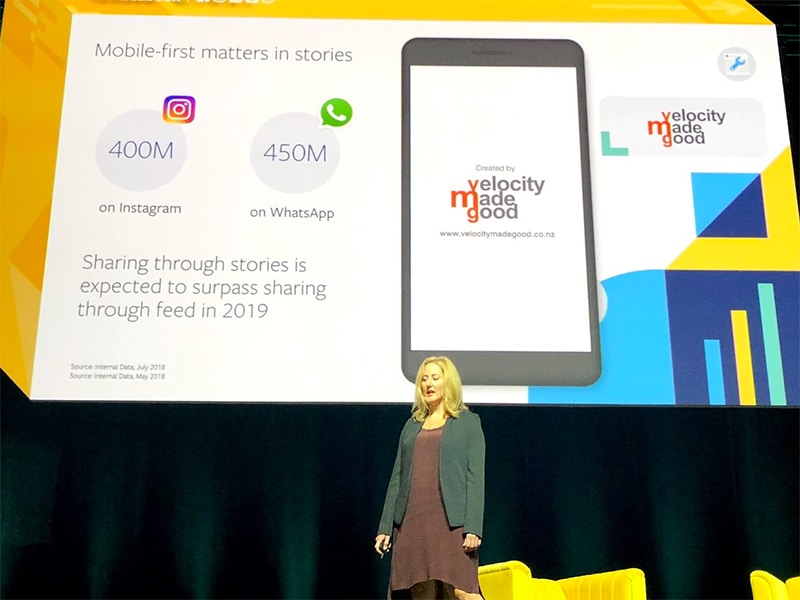
Here are the latest updates when it comes to Stories on social media:
LinkedIn launches Stories for Pages with swipe-up links
After introducing the Story format last year, LinkedIn just went a step further by announcing Stories for Pages, available for all Pages and Page admins.
Following the example of Instagram’s swipe-up links, they applied the same functionality within the Story frame.
The goal is for organizations to maximize engagement conversion and engage with their customers, partners and fans using the LinkedIn Stories format.
This is how it works:
- Post a Story
- Use the ‘swipe up’ option
- Once users click on it, they will be redirected to your desired URL destination.
It sounds familiar, right?
New Stories Panel at the top of Pinterest’s feeds for reaching the community
Pinterest showed that despite being a platform for finding inspiration, it’s also a great place for creators to reach their communities and share their passion and interests with like-minded people.
Since the beginning of January, some Pinterest users have noted a more dynamic format of the Stories panel, with a unique visual flair. This is not a bug. 🙂 Pinterest tests a new Stories panel at the top of the user’s Feed.
This is what it looks like:
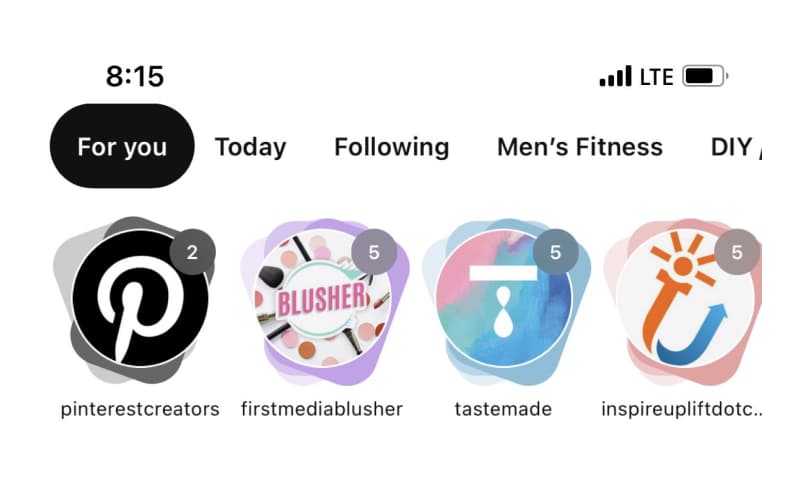
Wait a minute before you roll your eyes and say this is already a familiar format. Story Pins are not the same as Stories on other apps. The difference is that Story Pins live within a Pin, and they don’t disappear after 24 hours.
This feature is still in testing, but it will be rolled out to every user’s profile in the upcoming months.
However, this looks like an exciting, engaging way to generate interest in Story pins and, once again, prove Stories enormous popularity.
Instagram is testing a new way to display Stories on desktop

Although users connect to Instagram mostly on mobile phones, it shows genuine care for its desktop version users.
As reported by Engadget, Instagram started redesigning parts of the UI to suit the big screen better. One of them is transforming Instagram Stories into a carousel format to give users an easier way to go through Stories on a desktop.
The new design’s goal is to make Story discovery and consumption a lot better and minimize the need for extra clicks.
What can we expect next?
Just 2 years ago, we thought chatbots would critically replace sales and customer service. Now, it turns out that this trend is adopted but not at all critical.
The importance of following trends is to try them out, test them in your own industry, and see what will stick.
Don’t sit and wait for your competition to get unfair advantages just by adopting social networks where some of your new customers might spend much more time.
Just be aware, follow, and read, and we are here to update you on everything.
At this point, we are closely monitoring what might be the next social media trend.
And the ‘to watch’ list for new trends is the following:
- Augmented reality;
- Live streaming and real-time podcasting;
- Instagram and TikTok videos are displayed at the top of the Google mobile search results.
To wrap up
Have we missed any social media trends? We are continually updating this article, so drop us a line and let us know which social media trend deserves to be part of this list.
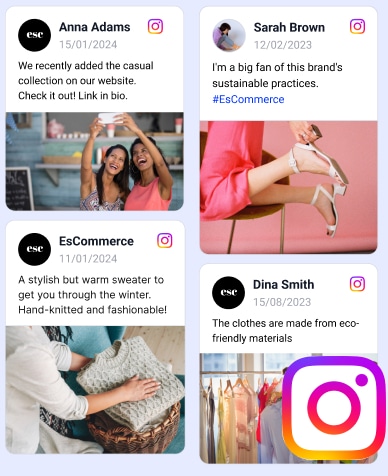
Display social media wall on your website automatically!
Try our Social media aggregator and display Instagram, Facebook, YouTube, Pinterest, TikTok, and LinkedIn feeds on your website in seconds.

